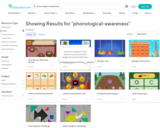
Making learning time as a family, fun time together.
- Subject:
- English Language Arts
- Material Type:
- Primary Source
- Author:
- abclifeliteracy.ca
- Date Added:
- 12/07/2018

Making learning time as a family, fun time together.

Although this free resource was developed with the state of Alaska in mind, it includes a tremendous amount of great information and strategies that apply to the teaching of reading universally. A definite must-have for your toolkit!
This playbook combines decades of nationwide research with examples and resources developed by educators in the state of Alaska. You’ll find an introduction to phonological awareness, phonics, vocabulary, fluency, and comprehension. You will also find links to valuable resources where you can continue to deepen your knowledge.

You know that if you can foster a love of reading in your children at a young age, they’ll have skills and insights that will last them a lifetime. The good news is that there are so many fantastic options when it comes to children’s books, from old classics to new hits. That’s why we’re here.

Book sharing is an activity that is enjoyable for all age groups. Reading, looking at and talking about the pictures, and making up a story to go with the pictures are some ways to share books with children. Here are some helpful tips to use when choosing or sharing a book with your child.

This is a video recording of the lunch and learn session from October 21st, 2021 on how the brain learns to read. Session Description: Do you wonder how our students brains learn to read? Join this session for an overview of what the scientific field has discovered and uncovered about our brains and the process the brain goes through to learn how to read. This will have a significant impact on how we plan to teach reading, writing, and spelling in the future.
![Dyslexia Toolkit [Free Download]](https://img.oercommons.org/160x134/microsite-sws-prod/media/upload/materials/screenshots/materials-course-17942.png)
As awareness of dyslexia in early literacy grows, more and more questions have emerged about the learning challenge and how to better identify and support students at risk.
This new toolkit offers explicit answers for educators looking to learn about dyslexia and how to effectively screen for it to ensure students are supported as early and as effectively as possible.
With this toolkit, educators can better understand topics like:
- Dyslexia: What exactly is it?
- How to screen for at-risk students (and what actually works)
- Dyslexia legislation enacted in recent years
Sign up to receive your toolkit today!

The Early Learning Portal provides current information on these initiatives, easy access to early years documents, resources and learning opportunities created to support those working with young children and their families in Saskatchewan. We encourage educators working with children in the early years to access the portal for information.

"Six videos have been created to highlight strategies that support language development for young children. The Enhancing Young Children’s Language and Literacy Development video series features interactions between Saskatchewan early childhood educators and children, and offers practical suggestions for implementing language and early literacy strategies.
Each video is approximately 15 minutes in length and includes information and examples for the continuum of early years development from 0-5 years of age. The videos will be useful for educators and staff who work with young children.
Video Titles include:
Getting in Tune with Children;
Incorporating Vocabulary into Routines;
Adjust the Way You Talk with Children;
Turn Taking with Children;
Sharing Books with Children; and,
Oral Storytelling with Children."

A Comprehensive, Step-By-Step Program for Developing Phonemic Awareness and Fluent Word Recognition

This resource is for anyone who works with and cares for young children. The word “parent” is inclusive of all those who contribute to the development and lifelong learning of children.
Remember that no two children are alike. No two parents are alike. Your child will learn and grow at his own pace.
Parents are a child’s most important teachers. As your child’s first teacher, you can provide opportunities that will give your child a love of reading. Read to your child every day. Let your child see you reading.
This booklet gives a few suggestions on how to help your child discover the love of reading. It also lets you as a parent know why you are so important in the life of your child.

ELA games for preschool to Grade 5.
There are games for everything from grammar, vocabulary, spelling, and phonics!

Set your little one up for reading success with these interactive games that will build phonological awareness—the ability to recognize and understand sounds in words. Your child will learn to master vowel sounds, digraphs, blended sounds, and more as they find themselves embarking on a photoshoot, playing bumper cars, or soaring through the sky in these fun-filled phonics games!
Students can play three games for free.

• Covers everything from letters and sounds to reading full sentences.
• Designed in collaboration with leading academics.
• Complements all synthetic phonics programmes used in schools.
• Computer version is 100% free.
Be sure to check out the free math game as well!

FreeReading is an open source instructional program that helps educators teach early literacy. Because it is open source, it represents the collective wisdom of a wide community of teachers and researchers. FreeReading contains, Intervention A, a 40-week scope and sequence of primarily phonological awareness and phonics activities that can support and supplement a typical kindergarten or first grade "core" or "basal" program.

As your child’s first teacher, you will help your child learn to walk, talk, play, count, express feelings, regulate emotions, share, love, and much more. These milestones are best achieved by providing a safe and caring environment for the healthy growth and development of your child.

Learn how to take a running record on any book!

Modelled Reading
Shared Reading
Scaffolded/Guided Reading
Independent Reading
These are all examined with the transfer of responsibility. This document should form the basis of a good reading program. All types of lessons must be included.

This website provides short support videos by grade level for:
*readers have different voices
*readers make inferences
*readers retell/summarize
*readers question and predict
*readers track details
*readers juggle multiple texts
*SEL

Practical advice and high impact teaching practices that improve outcomes in reading, writing and speaking and listening.
Guides are available for elementary schools and early education (birth to 5 years) as well.
Sections are included for Reading, Writing, Speaking, Listening, Interacting with Others, Emergent Literacy and within those areas you will find teaching practices, videos, sample phonics lessons, in practice examples and more.
A teaching tooklit map is provided to grade 6 with links to many of the items on the map! https://www.education.vic.gov.au/Documents/childhood/professionals/learning/literacy/lttusermap-ec.pdf (birth to 5)
https://www.education.vic.gov.au/Documents/school/teachers/teachingresources/discipline/english/literacy/lttusermap.pdf (Gr. 1 to 6)

This is a listening activity, intended to help students with their listening skills. The activity is a reading of the book "Barnyard Dance" written by Sandra Boynton, read by Heather Phillips, that includes dance like instructions for students to do as they listen.